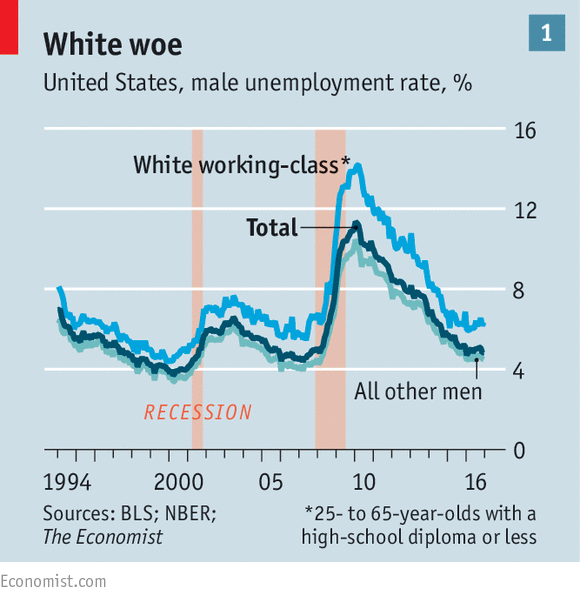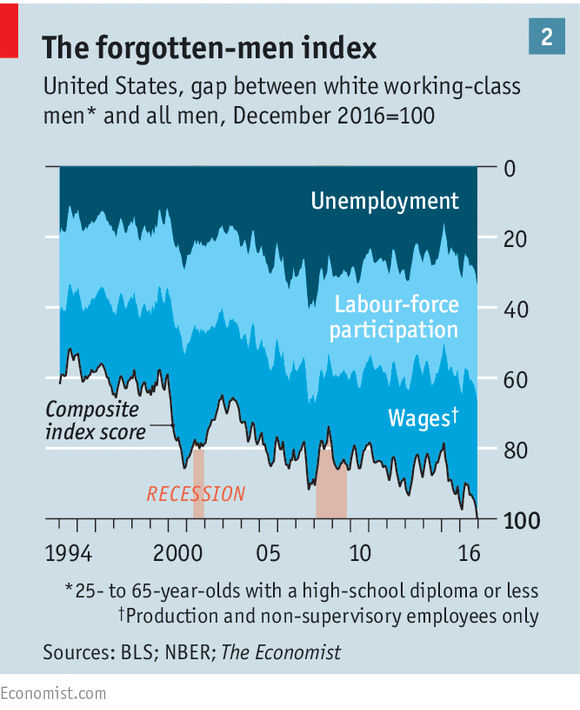Post by Trades on Feb 23, 2017 19:34:12 GMT -5
The forgotten-men index
Tracking the fortunes of the white working-class
Our new labour-market index
www.economist.com/news/united-states/21717068-our-new-labour-market-index-tracking-fortunes-white-working-class?frsc=dg%7Ca
Tracking the fortunes of the white working-class
Our new labour-market index
Feb 18th 2017
IN 1922 Donald Trump’s father, Fred, left high school at 16 to work for a carpenter. He was a “very smart guy” who could “add five columns of numbers in his head”. Construction came naturally to him, too. By 1971 he had amassed a multi-million-dollar fortune. Working-class success stories like Fred’s are rare in America, and becoming rarer. The president wants to see more of them.
At his inauguration he declared that America’s “forgotten men and women” will “be forgotten no longer”. And he has vowed to bring back jobs to states that have been “hurt so badly” by globalisation. By America’s forgotten people, he means above all white working-class men: three-quarters of white men who left school at 18 and voted in November did so for Mr Trump, the highest share of any demographic group.
White men are also Mr Trump’s most loyal supporters. While his approval ratings languish at 49% nationwide, among working-class white men they are at 69%, according to YouGov, a pollster. This group also forms a big chunk of the labour force: non-Hispanic white men aged 25 to 65 with a high-school diploma or less make up 23% of male workers.
Mr Trump has little of his father’s precision with figures. A year ago he reckoned that the unemployment rate—rather than hovering around 5% as the official statistics showed—was “probably 28, 29, as high as 35” or even, perhaps, “42%”. To help clarify things, The Economist has created a set of labour-market indicators to track the progress of America’s forgotten men. Our index of white working-class males (WWCM) employs three measures of job performance.

First, the unemployment rate. This counts the number of jobless people who have actively sought work in the past four weeks, as a percentage of the total labour force. At the end of 2016 the rate stood at 4.7%, but among WWCM it was 6.4%: a difference of 30% (see chart 1). Between 1994 and 2001 the average gap in unemployment rates between all men and WWCM was only 15%. Since the start of the Great Recession that average gap has swelled to 24%.
Second, because the unemployment rate doesn’t count people who have given up looking for work, some argue that it underestimates the true extent of joblessness. So the second indicator is labour-force participation, which counts workers, employed or not, as a percentage of the working-age population. This has fallen steadily, from 87% in 1948 to 69% today. For WWCM it has declined to 59% (a proportionate gap of 15%, compared with an average of 10% between 1994 and 2001).

Finally, over the past 27 years, average hourly wages have risen by 2.9% a year before adjusting for inflation. Meanwhile the hourly earnings of WWCM (industries weighted by their share of WWCM employees) have increased by 2.8% a year. A small difference but, when compounded over 27 years, the gap in wage levels between all workers and WWCM has widened from an average of 3.7% in 1990-92 to 6.9% over the past two years.
Compiling these three indicators in an equally weighted index provides a month-to-month indicator of Mr Trump’s performance in the WWCM labour market (see chart 2). The index has shown deterioration in recent years. Could Fred Trump’s son make a difference?
This article appeared in the United States section of the print edition under the headline "Forgotten men"
IN 1922 Donald Trump’s father, Fred, left high school at 16 to work for a carpenter. He was a “very smart guy” who could “add five columns of numbers in his head”. Construction came naturally to him, too. By 1971 he had amassed a multi-million-dollar fortune. Working-class success stories like Fred’s are rare in America, and becoming rarer. The president wants to see more of them.
At his inauguration he declared that America’s “forgotten men and women” will “be forgotten no longer”. And he has vowed to bring back jobs to states that have been “hurt so badly” by globalisation. By America’s forgotten people, he means above all white working-class men: three-quarters of white men who left school at 18 and voted in November did so for Mr Trump, the highest share of any demographic group.
White men are also Mr Trump’s most loyal supporters. While his approval ratings languish at 49% nationwide, among working-class white men they are at 69%, according to YouGov, a pollster. This group also forms a big chunk of the labour force: non-Hispanic white men aged 25 to 65 with a high-school diploma or less make up 23% of male workers.
Mr Trump has little of his father’s precision with figures. A year ago he reckoned that the unemployment rate—rather than hovering around 5% as the official statistics showed—was “probably 28, 29, as high as 35” or even, perhaps, “42%”. To help clarify things, The Economist has created a set of labour-market indicators to track the progress of America’s forgotten men. Our index of white working-class males (WWCM) employs three measures of job performance.

First, the unemployment rate. This counts the number of jobless people who have actively sought work in the past four weeks, as a percentage of the total labour force. At the end of 2016 the rate stood at 4.7%, but among WWCM it was 6.4%: a difference of 30% (see chart 1). Between 1994 and 2001 the average gap in unemployment rates between all men and WWCM was only 15%. Since the start of the Great Recession that average gap has swelled to 24%.
Second, because the unemployment rate doesn’t count people who have given up looking for work, some argue that it underestimates the true extent of joblessness. So the second indicator is labour-force participation, which counts workers, employed or not, as a percentage of the working-age population. This has fallen steadily, from 87% in 1948 to 69% today. For WWCM it has declined to 59% (a proportionate gap of 15%, compared with an average of 10% between 1994 and 2001).

Finally, over the past 27 years, average hourly wages have risen by 2.9% a year before adjusting for inflation. Meanwhile the hourly earnings of WWCM (industries weighted by their share of WWCM employees) have increased by 2.8% a year. A small difference but, when compounded over 27 years, the gap in wage levels between all workers and WWCM has widened from an average of 3.7% in 1990-92 to 6.9% over the past two years.
Compiling these three indicators in an equally weighted index provides a month-to-month indicator of Mr Trump’s performance in the WWCM labour market (see chart 2). The index has shown deterioration in recent years. Could Fred Trump’s son make a difference?
This article appeared in the United States section of the print edition under the headline "Forgotten men"







